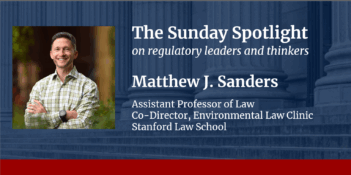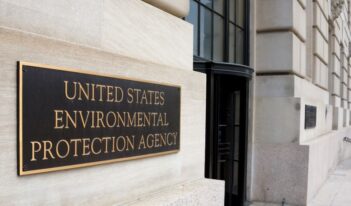
Scholars argue that as EPA deregulates, nuisance suits could replace traditional environmental regulation.
Since the 1970s, the Clean Air Act and the Clean Water Act—and the regulations issued under their authority—have formed the bedrock of U.S. environmental protections. But as the Trump Administration pursues its deregulatory agenda, environmental advocates have begun looking for alternative legal strategies to combat polluters.
In their paper, two scholars argue that the shift in federal environmental policy could revive an arcane body of law as a tool to fight climate change: the common law of interstate nuisance. Although the U.S. Environmental Protection Agency (EPA) was established to develop and enforce environmental regulations, Professors Mark Nevitt and Robert V. Percival argue that a federal retreat from enforcing anti-pollution statutes could open the door to individuals and states suing polluters for interstate nuisance.
Public nuisance lawsuits have long involved one party suing another for unreasonably interfering with rights “common to the public.” Nevitt and Percival note that these claims were a key vehicle for environmental protection and for holding interstate polluters accountable in the early 20th century, decades before EPA began regulating. These early cases often involved states challenging out-of-state factories that emitted water and air pollution that drifted across state boundaries.
The U.S. Supreme Court, however, has ruled that modern federal environmental statutes largely displaced public nuisance law claims against interstate polluters. In American Electric Power Co., Inc. (AEP) v. Connecticut, for example, New York City and eight states sued six major U.S. electric utilities providers, arguing that the defendants’ plants contributed significantly to the United States’ greenhouse gas emissions and rate of climate change. Deciding the case in 2010, the Supreme Court held that the Clean Air Act precluded federal common law nuisance claims regarding greenhouse gas emissions—thus blocking the plaintiffs’ claim—because the law granted EPA authority to regulate climate change. The Court reasoned that because the U.S. Congress delegated regulatory authority to EPA, the courts should not intervene in climate change regulatory matters.
The Court’s ruling came shortly after a major turning point in EPA policymaking, when the agency, under its authority granted by the Clean Air Act, issued its “endangerment finding.” This finding recognized the public health threats of greenhouse gases because they contribute to climate change. The finding also laid the groundwork for a slate of EPA rules targeting carbon dioxide emissions, such as more rigorous efficiency and emissions requirements for cars and trucks and stricter methane pollution rules.
But the Court’s specific holding, blocking a common law nuisance claim over greenhouse gas emissions, did not permanently prohibit such litigation, according to Nevitt and Percival. Instead, the Supreme Court’s ruling in AEP “was predicated on EPA actually making a reasoned and informed judgment of [greenhouse gas] emission dangers—not jettisoning agency expertise in favor of politics,” they argue.
And that disregard for expertise is exactly what has happened under the Trump Administration, Nevitt and Percival say. Since President Donald J. Trump’s inauguration, EPA has taken steps to delay, rescind, and replace numerous Obama-era regulations, including the Clean Power Plan and methane emission reporting requirements.
Nevitt and Percival explore a few possible developments that might undermine the basis for the Supreme Court’s holding in AEP and that could pave the way for nuisance law’s revival in the climate change context.
First, the most obvious possibility is that EPA reverses its endangerment finding. That said, Nevitt and Percival argue, even such an extreme step likely would not be enough to displace nuisance claims, as it is unlikely that the Supreme Court would uphold such a move by the agency. Instead, for the Court to determine that the Clean Air Act no longer displaces federal common law nuisance claims, Congress would likely have to amend the statute to strip EPA’s authority to regulate greenhouse gas emissions.
Nevitt and Percival also argue that nuisance law claims would be particularly successful if brought by state governments against EPA. These suits could more likely reach the legal merits, they write, because the Supreme Court has historically been more attentive to the needs and rights of “quasi-sovereign” entities like states. The Court has granted this solicitude because, as Justice Oliver Wendell Homes wrote, a state should have the “last word as to whether its mountains shall be stripped of their forests and its inhabitants shall breathe pure air.”
Arguing for the viability of nuisance law claims, though, is not meant to endorse them as a replacement to administrative rulemaking, Nevitt and Percival say. Instead, they argue that the common law will remain an “essential backstop when existing regulatory authorities fail to address significant environmental problems.”
Although litigation is inherently retrospective and slow, Nevitt and Percival contend that the threat of common law suits can still encourage the legislative and executive branches to use proactively the authority granted them by the seminal environmental statutes.
Nevitt and Percival’s article appears in the Washington University Law Review.



